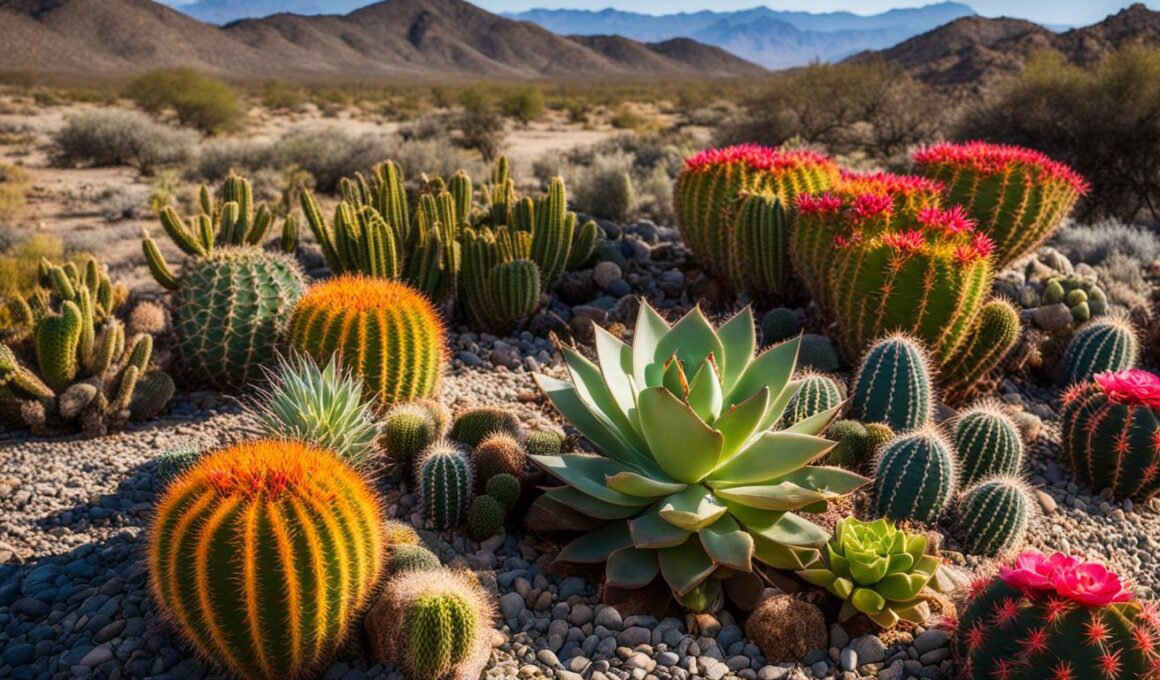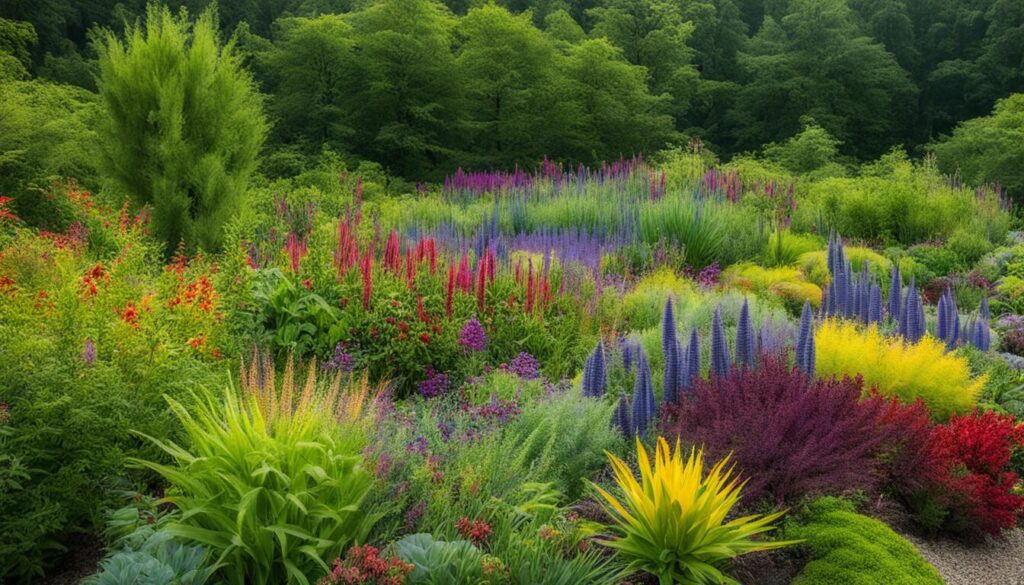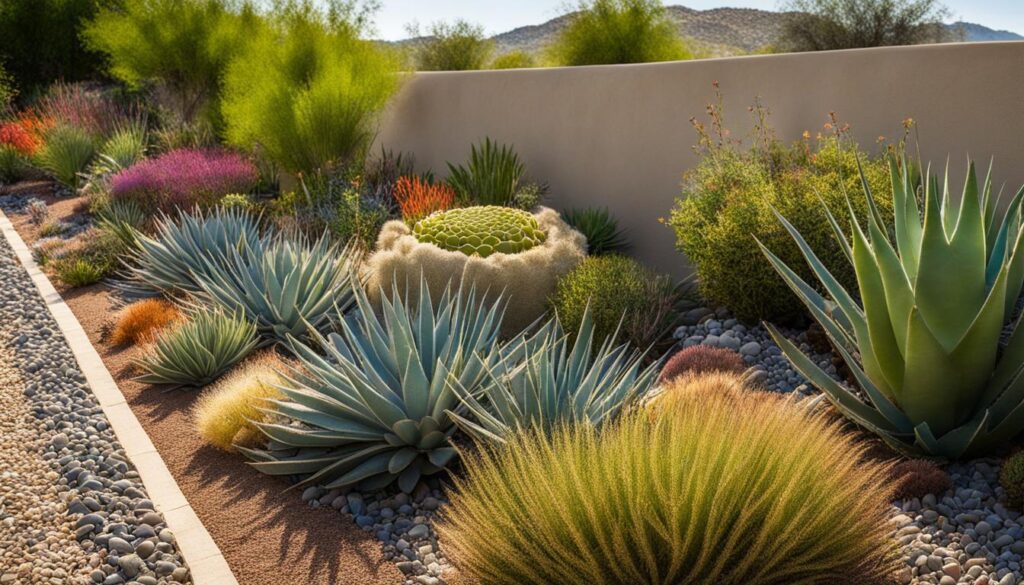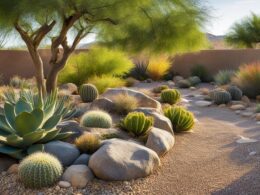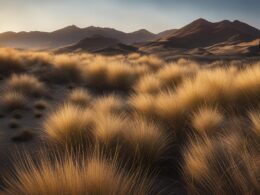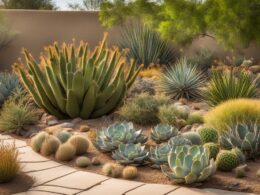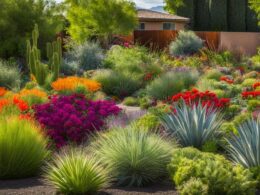Native xeriscape plants are a sustainable and practical choice for your US landscape. These plants have evolved to thrive in specific regions, making them well-suited for local conditions. By incorporating native plants into your yard, you can conserve water, reduce maintenance, and support the local ecosystem. In this guide, we will explore the benefits of choosing native plants, how to identify your landscape goals, selecting the right plants, where to find them, and how to create a successful xeriscape design. Let’s dive in!
Key Takeaways
- Choosing native plants for your US landscape can help conserve water and reduce maintenance.
- Native plants have evolved to thrive in specific regions, making them better suited for local conditions.
- Identifying your landscape goals and assessing your landscape conditions are crucial steps in selecting native plants.
- When choosing native plants, consider their water needs, growth habits, and characteristics such as color and texture.
- Buy native plants from reputable nurseries or explore online resources dedicated to native plant sales.
Benefits of Choosing Native Plants
Choosing native plants for your landscape offers a wide range of benefits, both for the environment and for your own outdoor space. Native plants are species that have evolved to thrive in specific regions and ecosystems, making them better adapted to local conditions. By incorporating native plants into your landscape, you can enjoy the following advantages:
- Water conservation: Native plants have adapted to their local environments and typically require less water than exotic plants. Their deep root systems help them access water more efficiently, reducing the need for irrigation. This can result in significant water savings, especially in regions prone to drought.
- Ecological importance: Native plants play a crucial role in supporting local ecosystems. They have established complex relationships with native insects, birds, and wildlife, providing them with essential food sources and habitat. By choosing native plants, you can help preserve biodiversity and contribute to the overall health of the ecosystem.
- Sustainability: Native plants are well-suited to their local environments, which means they require fewer pesticides and fertilizers compared to exotic plants. This reduces the impact on the environment and improves the overall sustainability of your landscape.
- Attracting pollinators: Native plants have co-evolved with local pollinators such as bees, butterflies, and hummingbirds. By incorporating a variety of native flowering plants in your landscape, you can create a pollinator-friendly environment and contribute to the conservation of these important species.
- Low maintenance: Native plants are adapted to the specific climate and soil conditions of their region, making them more resilient and less prone to diseases and pests. This can reduce the need for costly and time-consuming maintenance tasks, allowing you to spend more time enjoying your outdoor space.
By choosing native plants for your landscape, you can create a beautiful and sustainable outdoor environment while supporting the local ecosystem and conserving precious resources.
“Native plants play a crucial role in supporting local ecosystems, providing essential food sources and habitat for native insects, birds, and wildlife.”
Table: Comparing Water Requirements of Native and Exotic Plants
Below is a table comparing the water requirements of native plants and exotic plants commonly used in landscaping:
| Plant Type | Water Requirements |
|---|---|
| Native Plants | Low to Moderate |
| Exotic Plants | High |
The table clearly demonstrates that native plants generally have lower water requirements compared to exotic plants. This makes them an ideal choice for water-efficient landscaping, especially in regions where water conservation is a priority.
By choosing native plants, you can create a vibrant and resilient landscape that not only enhances the beauty of your outdoor space but also contributes to the overall health of the environment.
Identifying Your Landscape Goals
Before choosing native xeriscape plants, it is important to identify your landscape goals. Consider factors such as reducing maintenance, attracting specific wildlife, providing food sources, and achieving a certain aesthetic. Assessment of the conditions in your landscape, including soil type, sunlight availability, and water availability, will help guide your selection of appropriate native plants.
Factors to Consider
Assessing your landscape conditions is crucial in determining the right native plants for your space. Start by evaluating the soil type, as different plants have varying soil preferences. Some native plants thrive in well-drained soils, while others prefer clay or sand. Next, consider the amount of sunlight your landscape receives throughout the day. This will help you choose plants that are suited to the light levels in your yard. Lastly, evaluate the water availability in your area. Native plants are generally more drought-tolerant and can withstand periods of low water availability. Understanding these factors will ensure that you select plants that are well-adapted to your specific landscape.
Setting Landscape Goals
When setting your landscape goals, think about the overall vision you have for your outdoor space. Are you looking for a low-maintenance garden with minimal upkeep? Or do you want to create a habitat for specific wildlife, such as birds or butterflies? Consider your personal preferences and the unique characteristics of your landscape. By setting clear goals, you can make informed decisions when choosing native plants and create a landscape that meets your aesthetic and ecological desires.
Seeking Professional Advice
If you are unsure about the suitability of certain native plants for your specific landscape goals, don’t hesitate to seek professional advice. Local nurseries and horticultural experts can provide valuable insights and recommendations based on your location and requirements. They can help you navigate the selection process, ensuring that the plants you choose will thrive in your landscape. Additionally, online resources and gardening forums can provide a wealth of information and support, offering guidance from experienced gardeners who have successfully incorporated native plants into their landscapes.
| Landscape Goals | Considerations |
|---|---|
| Reducing Maintenance | Choose low-maintenance native plants that require minimal watering, pruning, and fertilization. |
| Attracting Wildlife | Select native plants that provide food, shelter, and nesting sites for wildlife species you wish to attract. |
| Creating Aesthetic Appeal | Consider the color, texture, and height of native plants to create a visually appealing landscape. |
| Conserving Water | Choose drought-tolerant native plants that can survive with limited water resources. |
Selecting the Right Native Plants
When it comes to choosing native plants for your landscape, there are several factors to consider. By selecting the appropriate plants for your area, you can ensure that they thrive in your specific region and climate. This will help create a sustainable and low-maintenance landscape that supports local ecosystems and conserves water.
One important consideration when selecting native plants is their water needs. Different plant species have varying levels of drought tolerance, so it’s essential to choose plants that are well-suited to the water availability in your area. This will help minimize the need for additional irrigation and conserve water resources.
Another aspect to consider is the growth habits and characteristics of the plants. Native plants come in a variety of colors, textures, and fragrances, allowing you to create a visually appealing landscape. Consider your landscape goals and the aesthetic you want to achieve when selecting plants. This will help create a cohesive and harmonious design.
Table: Native Plants for Different Climate Zones
| Climate Zone | Examples of Native Plants |
|---|---|
| Desert | Cactus, Agave, Desert Marigold |
| Coastal | Beach Aster, California Poppy, Sea Lavender |
| Mountain | Rocky Mountain Columbine, Indian Paintbrush, Blue Flax |
| Grassland | Switchgrass, Blazing Star, Purple Coneflower |
Lastly, it is crucial to acquire native plants from reputable nurseries that specialize in native species. Buying from these nurseries ensures that you are getting plants that are properly propagated and suited for your area. Avoid acquiring native plants from the wild, as it can be detrimental to natural ecosystems.
By carefully selecting native plants for your landscape, you can create a beautiful and sustainable outdoor environment that benefits both your property and the environment. Consider consulting with local experts or resources to get recommendations for the best native plants for your area and specific landscape goals.
Where to Find Native Plants
When it comes to buying native plants for your landscape, it is crucial to find reputable nurseries that specialize in native species. These nurseries have the expertise and knowledge to guide you in selecting the right plants for your specific location and requirements. They can provide valuable insights on water needs, growth habits, and characteristics of different native plants.
One option is to visit local nurseries in your area. They often carry a variety of native plants that are suited to the specific region and climate. By purchasing plants from local nurseries, you are supporting local businesses and ensuring that the plants are well-adapted to your area.
If you are having trouble finding specific native plants locally, you can ask your local nursery to order them for you. They may have access to a wider range of native plant species and can help fulfill your specific landscaping needs.
Additionally, there are online resources available for purchasing native plants. Websites such as Native Plant Societies or Native Plant Nurseries offer a wide selection of native plants that can be shipped directly to your doorstep. When using online resources, make sure to research the reputation of the seller and read customer reviews to ensure the quality and authenticity of the plants.
Table: Reputable Nurseries for Native Plants
| Nursery | Location | Website |
|---|---|---|
| Native Plant Nursery | California | www.nativeplantnursery.com |
| Wildflower Farm | Texas | www.wildflowerfarm.com |
| Flora Source | Florida | www.florasource.com |
| Native Gardens | Arizona | www.nativegardens.com |
Please note that the table above is for illustrative purposes only and does not endorse or recommend any specific nurseries.
Creating a Successful Xeriscape Design
To create a successful xeriscape design, careful planning and consideration of various factors are necessary. By following these guidelines, you can create a beautiful and water-efficient landscape that thrives in your specific environment.
Grouping Plants by Water Needs
One of the key principles of xeriscaping is grouping plants with similar water needs together. This allows for more efficient irrigation, ensuring that each plant receives the appropriate amount of water. Consider dividing your landscape into zones based on water requirements. For example, plants that require more water, such as lush perennials or flowering shrubs, can be grouped in one area, while drought-tolerant plants like succulents or native grasses can be grouped in another. This way, you can tailor your irrigation system to meet the specific needs of each zone.
Additionally, when selecting plants for your xeriscape design, choose species that are well-adapted to your local climate and soil conditions. Native plants are often a great option as they have evolved to thrive in the specific ecosystem of your region. They are more likely to withstand periods of drought and require less maintenance. Integrating various plant types, such as groundcovers, ornamental grasses, and native wildflowers, can add visual interest and diversity to your landscape while still conserving water.
Planning a Xeriscape Design
Before embarking on your xeriscape design, take the time to thoroughly assess your landscape. Consider factors such as topography, exposure to sunlight, and soil composition. Understanding these elements will help you select the most suitable plants and design a layout that maximizes water efficiency. For example, if you have a sloping yard, consider incorporating terraced plant beds to prevent soil erosion and allow for better water retention.
Furthermore, limit the use of turfgrass in your xeriscape design. While it may require a significant amount of water to maintain a lush, green lawn, there are alternatives that can provide a more sustainable and visually appealing landscape. Replace areas of grass with native groundcovers, such as creeping thyme or moss, or consider using hardscape features like gravel pathways or decorative rocks to add texture and interest.
| Plant Type | Water Needs | Maintenance Level |
|---|---|---|
| Native Wildflowers | Low | Low |
| Drought-Tolerant Grasses | Low to Medium | Low |
| Succulents | Low | Low |
| Ornamental Shrubs | Medium | Medium |
Remember to incorporate efficient irrigation systems into your xeriscape design. Drip irrigation is a highly recommended method as it delivers water directly to the root zone, minimizing wastage and evaporation. Mulching around plants can also help retain soil moisture and suppress weed growth. Choose organic mulch materials such as wood chips or bark, as they break down over time, enriching the soil.
By implementing these strategies, you can create a xeriscape design that not only conserves water but also enhances the beauty and functionality of your outdoor space. Remember to regularly assess your landscape, make adjustments as needed, and enjoy the benefits of a sustainable and thriving xeriscape.
What are the best native xeriscape plants to maximize my xerogarden?
When looking to maximize xerogardens native plant selection, consider lantana, Texas sage, and blackfoot daisy. These plants are hardy, require minimal water, and will thrive in a xeriscape environment. By carefully choosing the right native plants, you can create a beautiful, low-maintenance xerogarden.
Conclusion
In conclusion, incorporating native xeriscape plants into your landscape has numerous benefits. Not only do these plants require less water and maintenance, but they also support local ecosystems and wildlife populations. By choosing native plants, you contribute to water conservation efforts and create a beautiful and sustainable outdoor environment.
When selecting native plants, it is important to assess your landscape goals and consider factors such as water needs and climate suitability. Reputable nurseries specializing in native species are the best source for purchasing these plants. If you have trouble finding specific native plants, online resources can also be helpful.
To create a successful xeriscape design, plan your layout in advance and group plants with similar water needs together. Consider the topography, exposure, and soil conditions in your yard. By following these principles and seeking guidance from local experts, you can create a thriving and water-efficient landscape that benefits both your property and the environment.





